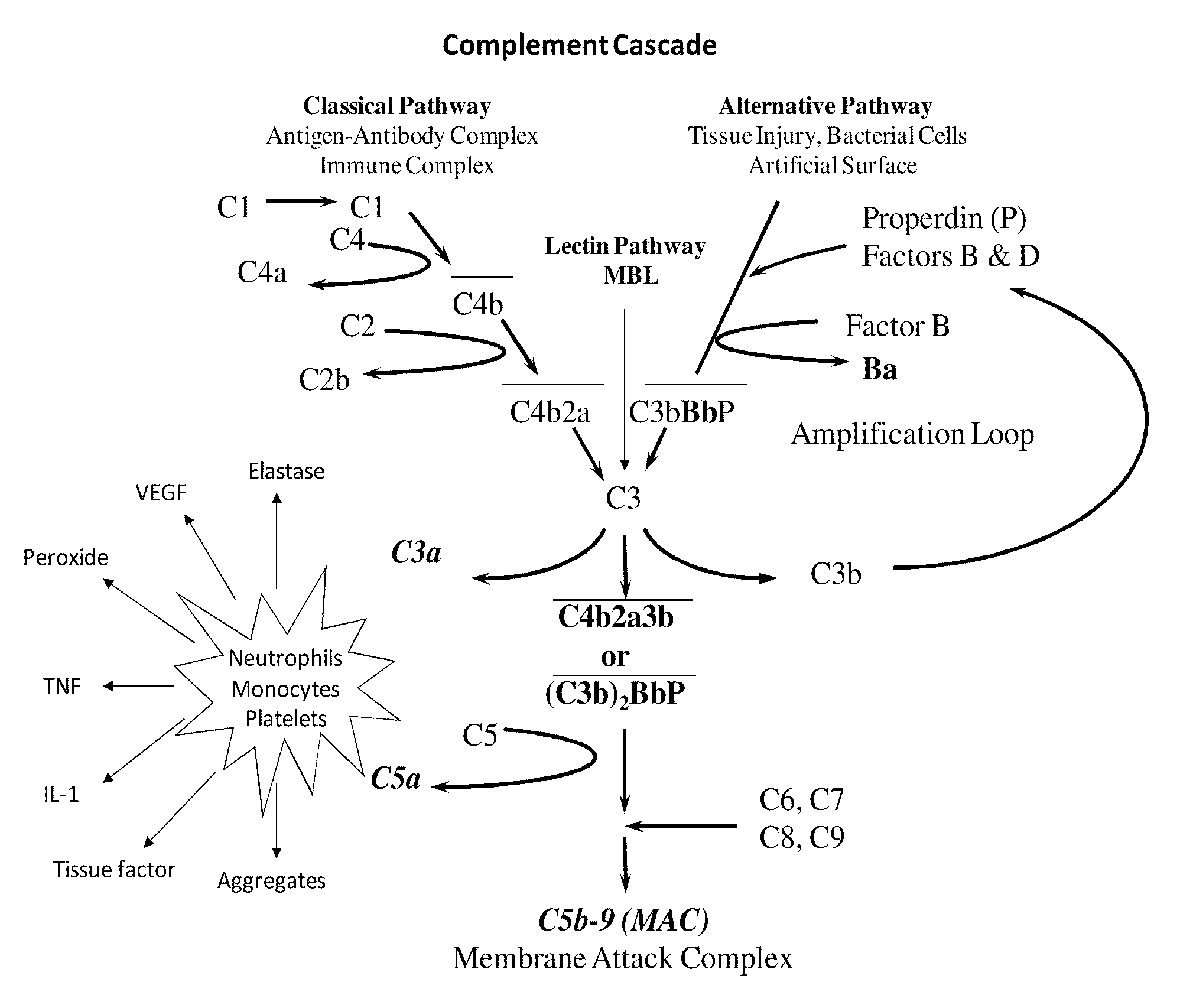METHOD OF INHIBITING COMPLEMENT ACTIVATION WITH FACTOR Ba SPECIFIC ANTIBODIES AND USE THEREOF
a technology of factor ba and specific antibodies, which is applied in the field of complement activation, can solve the problems of no approved drugs that can inhibit damage, organ damage, and potential threat to the host, and achieve the effect of inhibiting factor-b-dependent complement activation and reducing side effects of chemotherapeutic drugs
- Summary
- Abstract
- Description
- Claims
- Application Information
AI Technical Summary
Benefits of technology
Problems solved by technology
Method used
Image
Examples
example 1
Schematics Showing the Classical, the Lectin and the Alternative Complement Pathway
[0185]As shown, FIG. 3 both the classical pathway and the alternative pathway converge at C3. The C3 molecule is split into C3a and C3b by the action of C3 convertases. As the activation proceeds, C5a and C5b-9 are formed. Both C3a and C5a activate neutrophils, monocytes and platelets. Activated cells release inflammatory molecules.
example 2
Binding of Factor B to C3b and Properdin-Bound C3b
[0186]Polystyrene microtiter plates were coated with human C3b in phosphate buffered saline (PBS) overnight at 4 degree. After aspirating the C3b solution, wells were blocked with PBS containing 1% bovine serum albumin (BSA) for 2 hours at room temperature. Wells without C3b coating served as background controls. Aliquots of human factor B with and without properdin were added and plates were allowed to sit for 2 hours to the C3b coated wells to allow properdin and factor B binding. Following 2-hour incubation at room temperature, the wells were extensively rinsed with PBS and Factor B bound to properdin-bound C3b and C3b was detected by the addition of mouse monoclonal anti-human factor B antibody (detection antibody) at 1:1000 dilution in blocking solution, which was allowed to incubate for 1 hour at room temperature. After washing the plates with PBS, a peroxidase-conjugated goat anti-mouse antibody was added and allowed to incuba...
example 3
Factor B Does Not Bind iC3b, Cc, and C3dg With and Without Properdin
[0188]Polystyrene microtiter plates were coated with human iC3b, C3c, and C3dg in PBS overnight. After aspirating the respective solutions, wells were blocked with PBS containing 1% BSA for 2 hours at room temperature. Aliquots of human factor B at varying concentrations in blocking solution were added to the wells. Following 2-hour incubation at room temperature, the wells were extensively rinsed with PBS.
[0189]Protein-bound B was detected by the addition of mouse monoclonal anti-human factor B antibody (detection antibody) at 1:1000 dilution in blocking solution, which was allowed to incubate for 1 hour at room temperature. After washing the plates with PBS, a peroxidase-conjugated goat anti-mouse antibody was added and allowed to incubate for 1 hour. The plate was again rinsed thoroughly with PBS, and 3,3′,5,5′-tetramethyl benzidine (TMB) substrate was added. After incubation for 10 minutes at 25° C., the reactio...
PUM
| Property | Measurement | Unit |
|---|---|---|
| Chemotherapeutic properties | aaaaa | aaaaa |
Abstract
Description
Claims
Application Information
 Login to View More
Login to View More - R&D
- Intellectual Property
- Life Sciences
- Materials
- Tech Scout
- Unparalleled Data Quality
- Higher Quality Content
- 60% Fewer Hallucinations
Browse by: Latest US Patents, China's latest patents, Technical Efficacy Thesaurus, Application Domain, Technology Topic, Popular Technical Reports.
© 2025 PatSnap. All rights reserved.Legal|Privacy policy|Modern Slavery Act Transparency Statement|Sitemap|About US| Contact US: help@patsnap.com



